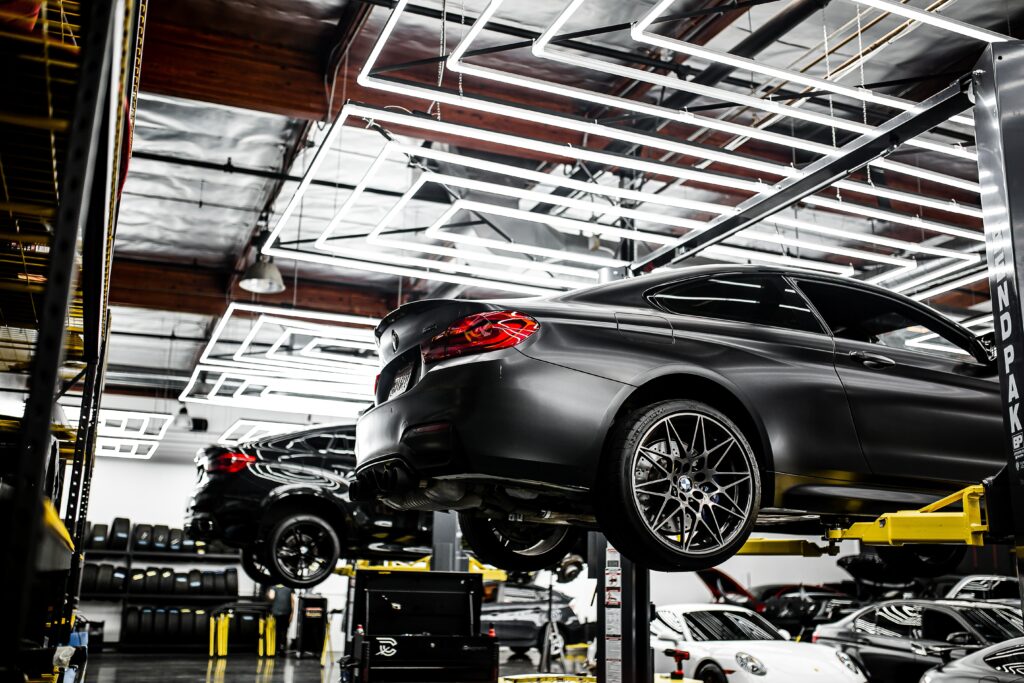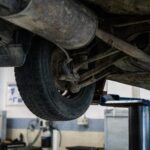The MacPherson strut suspension design, named after its inventor, Earle S. MacPherson, is an innovative suspension system that provides a cost-effective and space-saving solution for front suspensions. By integrating the shock absorber with other essential components, it simplifies the overall design of the vehicle.
The MacPherson strut suspension has become a staple in the automotive industry due to its efficiency and reliability. It eliminates the need for separate spring compressors or complicated mechanisms, making it easier to assemble during manufacturing. Not only does this save time and money but also ensures a more streamlined production process.
In simple terms, the MacPherson strut consists of a sturdy strut housing that encloses a shock absorber and supports a coil spring. Together, these elements work harmoniously to absorb bumps on rough roads while maintaining stability during turns. This results in improved handling and enhanced comfort for both driver and passengers.
Advantages of MacPherson Strut Suspension
Improved Handling and Stability on the Road
The suspension system plays a crucial role. The MacPherson strut suspension offers several advantages that contribute to improved handling and stability on the road.
Firstly, this type of suspension provides better control during cornering. The MacPherson strut design allows for independent movement between the wheel and body of the vehicle, reducing lateral forces and minimizing body roll. This means you can take those sharp turns with confidence, experiencing less sway and maintaining better traction on the road.
The MacPherson strut suspension improves overall stability while driving. By distributing weight more evenly across all four wheels, this system helps keep your vehicle balanced during acceleration, braking, and sudden maneuvers. This translates into a smoother ride and enhanced safety for both you and your passengers.
Simplified Design of Suspension System
Innovations in automotive engineering have led to various advancements in suspension systems over the years. One significant advantage of the MacPherson strut suspension is its simplified design compared to other types.
Unlike traditional double-wishbone or multi-link suspensions that require multiple components such as control arms, trailing arms, or linkages, the MacPherson strut combines several functions into one unit. It consists of a single assembly that incorporates both spring and shock absorber elements within a telescopic housing. This streamlined design not only reduces complexity but also saves space under the hood.
The simplified construction of the MacPherson strut suspension results in cost-effective manufacturing processes for automakers. With fewer parts involved, production becomes more efficient while still maintaining high performance standards. Furthermore, this simplicity facilitates easier troubleshooting and repair if any issues arise down the line.
Reduced Weight Compared to Other Suspension Types
Weight reduction has become an essential aspect in modern automotive engineering due to its impact on fuel efficiency and overall performance. The MacPherson strut suspension shines in this area as well, offering a weight advantage over other suspension types.
By integrating multiple components into a single unit, the MacPherson strut eliminates the need for additional linkages and control arms. This reduction in parts directly translates into a lighter overall suspension system. With less weight to carry, your vehicle can experience improved fuel economy and enhanced acceleration.
Furthermore, the reduced weight of the MacPherson strut suspension contributes to better handling dynamics. The lighter unsprung mass allows each wheel to respond more quickly to changes in road conditions, ensuring better tire contact with the pavement. As a result, you can enjoy a more responsive and agile driving experience.
Easier Installation and Maintenance
Simplicity is a major selling point for the MacPherson design. The MacPherson strut suspension excels in this aspect by providing an easier installation process and simplified maintenance requirements.
Thanks to its integrated design, installing a MacPherson strut suspension is relatively straightforward compared to other types that involve multiple components. With fewer parts involved, mechanics can save time during installation while ensuring proper alignment and fitment.
Moreover,The MacPherson strut suspension offers convenience. Since all critical elements are contained within one unit, troubleshooting becomes less complicated. Mechanics can easily access the entire assembly for inspection or replacement if necessary without having to dismantle various interconnected parts.
The simplified nature of the MacPherson strut also makes it easier for DIY enthusiasts who prefer working on their vehicles themselves. Whether it’s replacing worn-out struts or upgrading components for improved performance, this type of suspension allows for hassle-free maintenance without extensive technical knowledge.
Disadvantages of MacPherson Strut Suspension
Limited Adjustability
One of the drawbacks of the MacPherson strut suspension system is its limited adjustability compared to other suspension systems. While it provides a simple and cost-effective solution for many vehicles, its design restricts the ability to fine-tune and customize the suspension settings. This can be a disadvantage for those looking for precise handling characteristics or specific ride qualities.
Unlike more advanced suspension setups like double wishbone or multi-link systems, the MacPherson strut has fewer adjustable components. This means that adjustments such as camber, caster, and toe angles may be limited or non-existent. These settings play a crucial role in optimizing tire contact patch, stability during cornering, and overall handling performance. Therefore, enthusiasts who desire maximum control over their vehicle’s dynamics may find the MacPherson strut’s limited adjustability as a drawback.
Noise and Vibration Issues
Another potential downside of the MacPherson strut suspension is its susceptibility to noise and vibration issues. Due to its integrated design where the shock absorber is mounted inside the strut assembly itself, any problems with either component can result in unwanted noises or vibrations being transmitted into the cabin.
Over time, wear and tear can lead to degraded performance of the shock absorber or bushings within the strut assembly. This can manifest as clunking sounds when going over bumps or uneven road surfaces. If not properly maintained or if inferior quality components are used during repairs, excessive vibrations may occur while driving.
While advancements have been made in reducing these issues through improved materials and engineering techniques, it is important to note that compared to other types of suspensions, MacPherson struts may require more attention and maintenance to minimize noise and vibration problems.
Reinforcement for Heavy-Duty Applications
In heavy-duty applications such as trucks or SUVs with larger loads or towing capacities, one disadvantage of using MacPherson strut suspensions is the potential need for additional reinforcement. The design of MacPherson struts may not be inherently suited to handle the increased stress and weight that heavy-duty applications demand.
To compensate for these demands, manufacturers may need to reinforce various components of the suspension system. This can include using stronger materials, thicker sway bars, or even incorporating additional support structures.
The need for reinforcement adds complexity and cost to the overall suspension setup. It also limits the flexibility in terms of aftermarket modifications or upgrades since these reinforced components are often specific to each vehicle model.
Higher Replacement Costs
One drawback that drivers may encounter is higher replacement costs compared to other types of suspensions. This is primarily due to the integrated nature of the MacPherson strut design.
Unlike independent shock absorber setups where individual components can be replaced separately, MacPherson struts typically require replacing the entire assembly when one component fails or wears out. This means higher parts costs as well as increased labor expenses during installation.
Some vehicles with MacPherson struts may have more complex designs that require specialized tools or techniques for replacement. These factors contribute to higher overall replacement costs compared to other suspension systems.
MacPherson Strut Suspension Components and Variations
The MacPherson strut system is a popular type of suspension design used in many vehicles today. It consists of several key components that work together to provide a smooth and controlled ride. Let’s take a closer look at these components and explore the various variations of the MacPherson strut system.
Components of the MacPherson Strut System
- Strut Assembly: At the heart of the MacPherson strut system is the strut assembly itself. This component serves as both a structural support and a shock absorber for the vehicle. It connects the wheel hub to the body of the vehicle, allowing for vertical movement while minimizing vibrations and impacts from uneven road surfaces.
- Coil Spring: The coil spring plays a critical role in supporting the weight of the vehicle and providing stability during cornering and braking. It helps absorb shocks by compressing and expanding as needed, ensuring a comfortable ride for passengers.
- Lower Control Arm: The lower control arm connects the bottom end of the strut assembly to other suspension components, such as the steering knuckle or spindle. It helps maintain proper alignment and control over wheel movements, contributing to overall handling and stability.
- Stabilizer Bar (Sway Bar): The stabilizer bar, also known as a sway bar, is an important component that reduces body roll during cornering. It connects both sides of the suspension system together, resisting excessive leaning or tilting when turning sharply.
Variations of MacPherson Strut Suspension
- Single or Double Wishbone Designs: While most MacPherson struts feature a single wishbone design with one lower control arm, some variations utilize double wishbones on either side for added strength and improved handling characteristics.
- McPherson Strut with Auxiliary Spring: In certain applications where additional load-carrying capacity is required, an auxiliary spring may be added to the MacPherson strut system. This helps support heavy loads and maintains proper ride height under varying conditions.
- Electronic Damping Control: To enhance performance and adjust suspension settings on the fly, some MacPherson strut systems incorporate electronic damping control. This allows for real-time adjustments to the shock absorber’s characteristics based on driving conditions, ensuring optimal comfort and handling.
- Adjustable Camber Plates: MacPherson struts with adjustable camber plates offer the ability to fine-tune alignment settings. Camber refers to the angle of the wheels relative to the road surface. By adjusting camber, drivers can optimize tire contact with the road, improving grip and handling performance.
Exploring Suspension Design Variations
The use of MacPherson struts is not limited to passenger cars alone; they are also found in various other suspension systems such as trucks, SUVs, and even motorcycles. Each variation has its own advantages and caters to specific vehicle requirements.
For instance, double wishbone suspension systems provide superior control over wheel movements compared to single wishbone designs. They offer increased stability during high-speed maneuvers and better resistance against lateral forces.
In applications where heavy loads are common, variations with auxiliary springs ensure that the vehicle remains level and balanced regardless of cargo weight or passenger occupancy. This feature is particularly important in commercial vehicles or those used for towing purposes.
Electronic damping control takes suspension performance a step further by continuously adapting shock absorber settings based on sensor inputs such as vehicle speed, steering angle, and road conditions. This technology provides a more refined ride quality by instantly adjusting damping characteristics for optimal comfort and handling in any situation.
For enthusiasts who demand precise handling characteristics or participate in motorsports activities, MacPherson struts with adjustable camber plates allow for fine-tuning alignment settings according to individual preferences or track conditions. By optimizing camber angles, drivers can achieve better cornering grip and reduce tire wear.
Maintaining MacPherson Strut Bearings for Optimal Performance
Regular Inspection: Identifying Wear or Damage in the Bearings
Inspecting the MacPherson strut bearings on a regular basis is crucial for maintaining optimal performance and preventing potential issues down the line. These bearings play a vital role in supporting the weight of the vehicle while allowing for smooth steering and suspension movement. By visually examining the strut bearings, you can identify any signs of wear or damage that may affect their functionality.
During your inspection, pay close attention to any visible cracks, corrosion, or excessive play in the bearings. If you notice irregularities such as these, it’s essential to address them promptly to avoid further damage. Keep an eye out for leaking grease or unusual noises when turning the steering wheel, as these could indicate problems with the strut bearings.
Lubrication: Following Manufacturer Recommendations
Proper lubrication is key to ensuring that MacPherson strut bearings continue to perform optimally. The manufacturer will typically provide specific guidelines on how often lubrication should be performed and what type of lubricant should be used. It’s important to adhere to these recommendations as they are designed to maximize the lifespan and functionality of the bearings.
Lubricating the strut bearings helps reduce friction between moving parts, preventing premature wear and ensuring smooth operation. This is especially important considering that these bearings bear significant loads during steering maneuvers and absorb road impacts. By following proper lubrication procedures, you can help maintain optimal performance and extend the lifespan of your MacPherson strut bearings.
Replacement: Improving Ride Quality by Addressing Worn-Out Bearings
Over time, MacPherson strut bearings may become worn-out due to constant use and exposure to various driving conditions. When this happens, it’s crucial to replace them promptly to restore optimal ride quality and prevent further damage.
Worn-out strut bearings can result in several issues that impact both handling and comfort. These include increased noise and vibration, reduced steering response, and compromised suspension performance. By replacing worn-out bearings with new ones, you can eliminate these problems and ensure a smooth and controlled ride.
Proper Torquing: Preventing Premature Failure during Installation
During the installation of MacPherson strut bearings, proper torquing is essential to prevent premature failure. Torque refers to the amount of rotational force applied when tightening fasteners such as bolts or nuts. If the strut bearings are not correctly torqued, they may loosen over time, leading to potential safety hazards and decreased performance.
To ensure proper torquing, it’s crucial to follow the manufacturer’s specifications for your specific vehicle model. This information can typically be found in the vehicle’s service manual or obtained from reputable sources. By using a torque wrench and applying the recommended torque values during installation, you can help prevent premature failure of the strut bearings.
Conclusion: The Key Takeaways on MacPherson Strut
The MacPherson strut suspension system offers several advantages, but it also has its fair share of disadvantages. Understanding the components and variations of this suspension system is crucial for optimal performance. Proper maintenance of the MacPherson strut bearings is essential to ensure long-lasting functionality.
In summary, the key takeaways regarding MacPherson strut suspension are as follows:
- Advantages:
- Simplified design and cost-effectiveness make it a popular choice in many vehicles.
- Improved handling and stability due to reduced weight and unsprung mass.
- Easier installation and space-saving design compared to other suspension systems.
- Disadvantages:
- Limited adjustability, which can restrict customization options for specific driving preferences.
- Increased wear on tires due to limited camber adjustment capabilities.
- Reduced performance in extreme off-road conditions compared to more robust suspensions.
- Components and Variations:
- MacPherson struts consist of a shock absorber, coil spring, upper strut mount, lower control arm, and steering knuckle.
- Variations include different designs for the upper mount, such as double wishbone or multi-link setups.
- Maintaining MacPherson Strut Bearings:
- Regular inspections and lubrication help prevent premature wear and noise issues.
- Replacing worn-out bearings promptly is crucial to maintain optimal performance.
To make the most informed decision about your vehicle’s suspension needs, consider consulting with a trusted mechanic or automotive expert who can assess your specific requirements.
Aftermarket or Replacement Suspension Parts
I recommend using Tire Rack to buy suspension components. Whether you want to perform the maintenance yourself or just save money on the parts so your mechanic doesn’t upcharge you, Tire Rack is a great place to shop. They guarantee proper fitment for your vehicle by using a program where you can enter the year, model, make, and trim of your vehicle. They also offer a 30-day return policy on unused items and fast free shipping on every order over $50.

FAQs
Can I upgrade my vehicle’s suspension to a MacPherson strut system?
Yes, it may be possible to upgrade your vehicle’s suspension system to a MacPherson strut setup. However, it is essential to consult with an experienced mechanic or automotive professional who can evaluate compatibility and provide guidance based on your vehicle’s make and model.
Are MacPherson strut suspensions suitable for off-road driving?
While MacPherson strut suspensions offer benefits in terms of cost-effectiveness and space-saving design, they may not be the best choice for extreme off-road conditions. Other suspension systems, such as independent double wishbone or multi-link setups, are generally more robust and better suited for off-road adventures.
How often should I inspect my MacPherson strut bearings?
Regular inspections of your MacPherson strut bearings are recommended as part of routine maintenance. It is advisable to have them checked during scheduled service intervals or whenever you notice any unusual noises or handling issues.
Can I adjust the camber angle with a MacPherson strut suspension?
MacPherson strut suspensions typically offer limited camber adjustment capabilities. If you require precise camber adjustments for specific performance needs, it may be necessary to explore alternative suspension systems that provide greater adjustability.
Will upgrading to a MacPherson strut system improve my vehicle’s handling?
Upgrading to a MacPherson strut suspension can potentially enhance your vehicle’s handling characteristics. However, it is important to consider various factors such as compatibility, overall suspension setup, and other components like tires and alignment to achieve optimal results.
These FAQs address some common questions related to MacPherson struts but remember that consulting with an automotive professional will provide personalized advice based on your specific vehicle and requirements.





